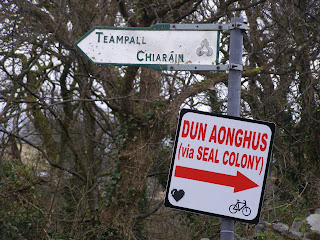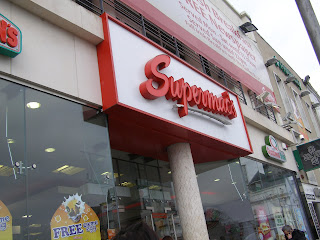Monday, April 30, 2012
Inis Mor
The Aran Isles are three islands off the west coast of Ireland, known for fishing and tourism. Inis Mor is the largest of the three, and Earthling and I spent the night in Kilronan, which is the largest ... evidence of civilization is probably the best way to describe it.
This was our B&B, which had absolutely scrumptious scrambled eggs and really comfy beds. Probably by best night's sleep during the entire stay in Ireland was here.
This is Guinness, who liked to greet all the guests at the B&B. Our best guess was that he was part Corgi and part something else.
Some views from the B&B:
...
After breakfast, Earthling and I took a walk along the coast of the island.
There was an artist hostel down this road.
We saw cows...
Some spectacular scenery...
Some quaint farmhouses stereotypical of what I think of when I think of rural British countryside...
Some interesting ruins...
Some horses, who were all quite anxious to come over and say Hi...
Some goats.
There's apparently a seal colony on Inis Mor, but we weren't planning on staying long enough to see it.
After the walk along the coast, we trekked back to Kilronan for some shopping and lunch. The Aran Isles are most known for the creating of intricately patterned fisherman sweaters, and as such, the big tourism draw in Kilronan is the Aran Sweater Museum.
Earthling and I spent some significant time here, perusing the sweaters for sale. The theory of an Aran sweater states that each family has its own unique pattern, and that each individual stitch has a symbolic meaning. I've yet to hear conclusive evidence to that fact (I've actually heard some pretty hard evidence that points to the opposite), but it's a nice theory anyway, and the sweaters there were pretty. Earthling and I bought enough yarn there for sweaters.
Lunch was at the pub across the street from the museum. I had Irish stew, which was nice on a raw, rainy day.
Some views of the harbor around Kilronan:
Another:
And another:
And another:
And another:
The ferry line that took us back to the mainland:
And then it was back to Galway after an eventful day.
Monday, April 16, 2012
Galway -- Part 1
So, it occurred to me the other day that I really out to post some of the pictures from my vacation so you all could see that I wasn't behaving. So here's the first segment.
Our first full day was in Galway, which is on the western side of Ireland, right on the coast. Earthling and I took the train there from Dublin and walked downtown from the train station (which is maybe two blocks from the square).
This is where we ate lunch that day -- generic fast food, served on china plates:
Across the street was Eyre Square, which Earthling and I both took as the central square in the city:
Along one of the streets running along side Eyre Square was a bunch of flagpoles showcasing various family crests:
As well as this bizarre piece of modern art
Across from Eyre Square was the old medieval section of Galway, full of cobblestone streets and loads of small shops and restaurants.
This is the Church of St. Nicholas, one of the oldest churches in Galway. After the Reformation, it became Church of Ireland (Anglican). The outside still has its medieval gargoyles, and the inside has the old original chapel.
This was on the outside of one of the buildings:
Neither Earthling nor I drink Guinness. We just thought it was funny.
That afternoon, we caught the bus down to the ferry dock to head on over to Inis Mor. Some views from the bus:
And here's another...
And here's another.
Next Posting: Inis Mor
Our first full day was in Galway, which is on the western side of Ireland, right on the coast. Earthling and I took the train there from Dublin and walked downtown from the train station (which is maybe two blocks from the square).
This is where we ate lunch that day -- generic fast food, served on china plates:
Across the street was Eyre Square, which Earthling and I both took as the central square in the city:
Along one of the streets running along side Eyre Square was a bunch of flagpoles showcasing various family crests:
As well as this bizarre piece of modern art
Across from Eyre Square was the old medieval section of Galway, full of cobblestone streets and loads of small shops and restaurants.
This is the Church of St. Nicholas, one of the oldest churches in Galway. After the Reformation, it became Church of Ireland (Anglican). The outside still has its medieval gargoyles, and the inside has the old original chapel.
This was on the outside of one of the buildings:
Neither Earthling nor I drink Guinness. We just thought it was funny.
That afternoon, we caught the bus down to the ferry dock to head on over to Inis Mor. Some views from the bus:
And here's another...
And here's another.
Next Posting: Inis Mor
Thursday, April 12, 2012
Interesting...
"A historical novel . . . is qualified to be called that if it is set 50 years prior to the date it was written."
That statement was made by BookList's Brad Hooper, requoted by his colleague Keir Graff. This would imply that Pride and Prejudice, written in 1813 about life in 1813 and specifically mentioned by both Hooper and Graff as an example, would not be considered historical. Likewise, Little Women, written in 1868 about events in 1862, and Harry Potter and the Philosopher's Stone, written in 1997 about events in 1991-92. It also means that books like Number the Stars, written in 1989 about events in 1943, would not be historical.
No offense to Hooper, but I'm not certain I agree with his assessment. While I do agree that Pride and Prejudice, for example, should not be considered historical, and that Harry Potter has enough fantasy in it to make it almost asynchronous, fifty years seems a bit stretchy. And, for that matter, totally relative and arbitrary. Why fifty? What makes that particular number so important?
Perhaps the number should be 30 years -- that seems to be when people begin reminiscing, and a lot of historical novels begin to come out There's been an influx in recent years of books about Vietnam, for example, although 30, like 50, seems rather arbitrary. My colleague S is of the opinion that a historical novel is any that is situated in a specific point in time, regardless of how long ago that point was.
What's your take? The following books all have plotlines that take place less than 50 years before publication. I've included the authors, the years the plots take place, and the years of publication. You tell me: Are they historical or not?
Number the Stars, Lois Lowry (1943/1989)
Meet Molly, Valerie Tripp (1944/1988)
Meet Julie, Megan McDonald (1974/2007)
Dead End in Norvelt, Jack Gantos (1962/2011)
When You Reach Me, Rebecca Stead (1979/2009)
All the Broken Pieces, Ann Burg (1977/2009)
Lucky, Wes Tooke (1961/2010)
Neil Armstrong Is My Uncle, Nan Marino (1969/2009)
Summer of My German Soldier, Bette Greene (1942/1973)
Where Have All the Flowers Gone? Ellen White (1968/2002)
Criss Cross, Lynne Perkins (1970/2005)
The Wednesday Wars, Gary Schmidt (1967/2007)
That statement was made by BookList's Brad Hooper, requoted by his colleague Keir Graff. This would imply that Pride and Prejudice, written in 1813 about life in 1813 and specifically mentioned by both Hooper and Graff as an example, would not be considered historical. Likewise, Little Women, written in 1868 about events in 1862, and Harry Potter and the Philosopher's Stone, written in 1997 about events in 1991-92. It also means that books like Number the Stars, written in 1989 about events in 1943, would not be historical.
No offense to Hooper, but I'm not certain I agree with his assessment. While I do agree that Pride and Prejudice, for example, should not be considered historical, and that Harry Potter has enough fantasy in it to make it almost asynchronous, fifty years seems a bit stretchy. And, for that matter, totally relative and arbitrary. Why fifty? What makes that particular number so important?
Perhaps the number should be 30 years -- that seems to be when people begin reminiscing, and a lot of historical novels begin to come out There's been an influx in recent years of books about Vietnam, for example, although 30, like 50, seems rather arbitrary. My colleague S is of the opinion that a historical novel is any that is situated in a specific point in time, regardless of how long ago that point was.
What's your take? The following books all have plotlines that take place less than 50 years before publication. I've included the authors, the years the plots take place, and the years of publication. You tell me: Are they historical or not?
Number the Stars, Lois Lowry (1943/1989)
Meet Molly, Valerie Tripp (1944/1988)
Meet Julie, Megan McDonald (1974/2007)
Dead End in Norvelt, Jack Gantos (1962/2011)
When You Reach Me, Rebecca Stead (1979/2009)
All the Broken Pieces, Ann Burg (1977/2009)
Lucky, Wes Tooke (1961/2010)
Neil Armstrong Is My Uncle, Nan Marino (1969/2009)
Summer of My German Soldier, Bette Greene (1942/1973)
Where Have All the Flowers Gone? Ellen White (1968/2002)
Criss Cross, Lynne Perkins (1970/2005)
The Wednesday Wars, Gary Schmidt (1967/2007)
Subscribe to:
Posts (Atom)






























